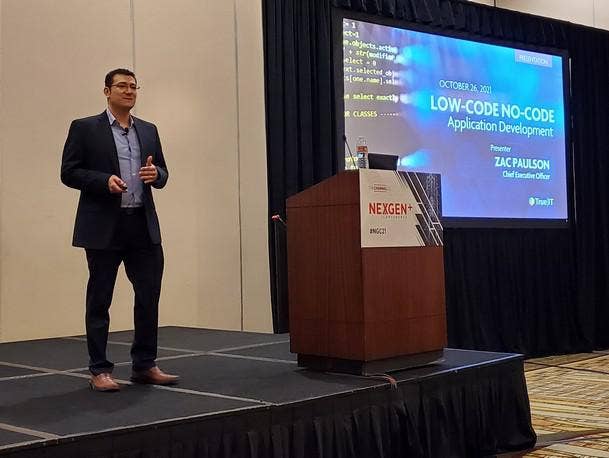Why Low-Code/No-Code Can Bring A ‘Distinct Advantage’ For MSPs
Using a low-code/no-code platform to create internal business apps is a major revenue opportunity and way to increase stickiness with customers, according to TrueIT CEO Zac Paulson.

For managed services providers, building low-code/no-code applications for customers is a huge opportunity for business growth and differentiation, since few MSPs are currently providing this service, according to the CEO of a managed services provider that’s active in the space.
Zac Paulson, CEO of Fargo, N.D.-based TrueIT, said Tuesday that low-code/no-code is often also a service that can be delivered with existing staff—which means it won’t require hiring scarce developer talent.
Low-code/no-code —which offers a visual approach to app development, often using drag-and-drop methods—is a great fit for creating internal apps that are used by customers to support their business, Paulson said during a session at NexGen+ 2021. The conference is hosted by CRN parent The Channel Company this week in Anaheim, Calif.
Low-code/no-code is an opportunity for additional revenue, as well as a chance to increase stickiness with the customer and fend off competitors, he said.
“If you build two or three little applications that help their business run more smoothly, when a competitor comes in—and offers to do their [IT services] for cheaper—the customer is going to say, ‘Yeah, but can you do [low-code/no-code]?’” Paulson said.
“And if they can’t—and I can promise you, lots of MSPs out there aren’t even touching this area—you have that distinct advantage,” he said. “As an MSP, more and more of our services are being commoditized. That’s just how the market works. Your unique value is something that the other MSPs just aren’t doing yet—and that’s something we have an opportunity to do [with low-code/no-code].”
After gaining an understanding of how the customer’s business functions and building apps around that, “you become so valuable,” Paulson said. “And then that helps you make other sales.”
Paulson said that TrueIT, which was founded in 2012, had previously offered traditional software development services to customers—but got out of that business in May of 2020 due to the advantages of focusing on low-code/no-code.
Nathan Phinney, director of business development at Modesto, Calif.-based solution provider DataPath, said it’s clear that the “opportunity is massive” for low-code/no-code.
“I don’t know if that’s for us yet, but it’s definitely an interesting area to explore,” Phinney said. “The vision for this kind of technology is that it removes barriers. Some of the bottlenecks that have existed between people and data are not there anymore.”
During the session, Paulson pointed to existing technologies that have eliminated the coding requirements for web publishing—such as WordPress—as forerunners to low-code/no-code platforms. The approach is quickly becoming the “WordPress of development,” he said.
Phinney said he thinks this characterization is on the mark. “When you publish a post on Squarespace or WordPress, code is being written,” he said. “It’s just we’ve automated a lot of those systems and processes. And a lot of the barriers to entry are getting smaller or they’ve been removed entirely.”
Low-code/no-code offers a number of other benefits over traditional development, including far fewer bugs and enabling customers to update and maintain their own apps, Paulson said.
MSPs will also often be able to deploy existing staff to do low-code/no-code work, he said. Ideal candidates can include existing engineers or network operations center staff, but Level 1 and Level 2 support staff can also be a great fit for low-code/no-code projects, Paulson said.
“It doesn’t require highly technical programmers,” he said. “You don’t have to go out to find new technical talent.”
Low-code/no-code is not a good solution for developing highly complex applications, or for developing software that will be customer-facing or serve as the basis for the whole business, Paulson noted.
Because the platforms tend to restrict your flexibility and lock you into their platform, “I’d probably advise sticking with internal applications for low-code/no-code,” he said.
Paulson said that as a Microsoft-focused MSP with a strong Dynamics 365 practice, TrueIT has focused on low-code/no-code platforms from Microsoft such as Power Apps and Power Automate. The Microsoft tools offer advantages including integrations throughout the company’s ecosystem of platforms, he said.
But numerous tools are available, including from Appian, AppSheet (owned by Google Cloud) and Zoho Creator, he said.
To get started—along with choosing a platform and determining which employees might be a fit for the work—it’s also worth identifying which clients would be ideal to target first, Paulson said.
Paulson recommended that MSPs focus on their “best” clients—and those are “not usually ones that are high maintenance.”
“What are the clients that you’re winning with today? What are the clients that everything you throw at them, they say, ‘Yes let’s try that’? Those are the clients that you should go to with this,” he said.
Paulson also offered examples of how TrueIT has used low-code/no-code to automate some of its own processes, such as for running a virtual standup meeting that automatically pings all employees on Microsoft Teams to ask what they’ve been working on.
Ultimately, even if low-code/no-code does not seem like an especially sophisticated technical offering, that doesn’t mean customers won’t be impressed by it, he said.
While many MSPs tend to take technology for granted, “your clients still think we do voodoo magic,” Paulson said. “You need to take advantage of that. Bring them in, show them what you can do. Because I promise you, if you’ve heard it here at NexGen, your customers probably haven’t heard of it before.”